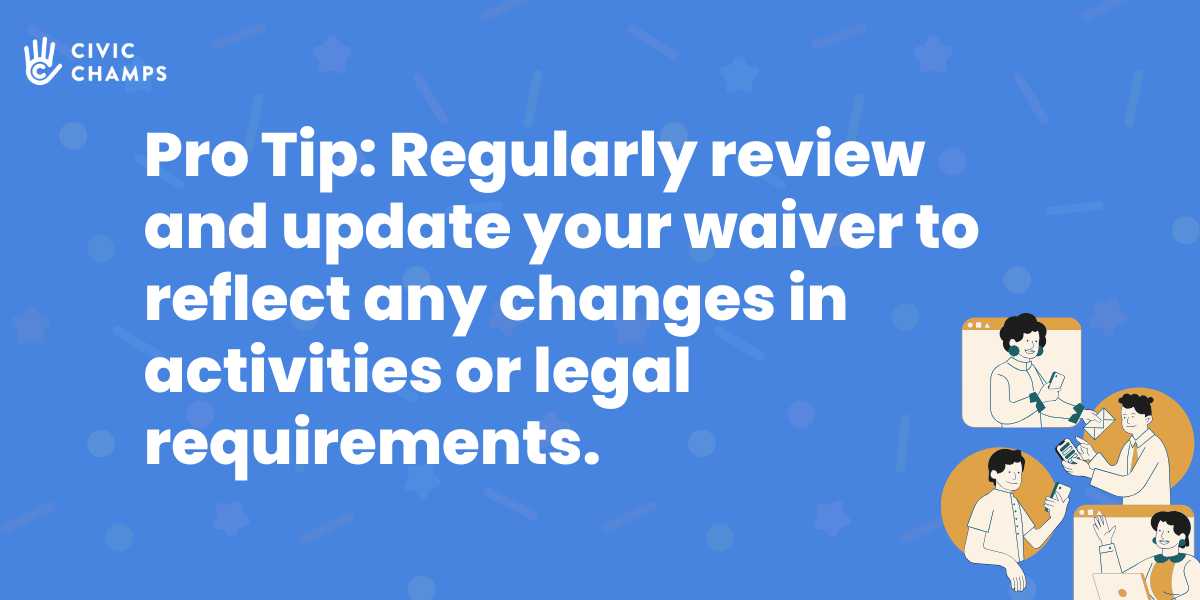In the world of nonprofit organizations, ensuring the safety and protection of both volunteers and the organization itself is paramount. One essential tool in achieving this is the non profit volunteer waiver form. This document serves as a legal agreement that outlines the rights and responsibilities of volunteers, helping to mitigate potential risks. Understanding the nuances of volunteer waivers can empower nonprofits to operate more effectively and confidently.
Can your rights really be waived?
Understanding the legal implications of waiving rights in a volunteer context is crucial for both organizations and volunteers. When a volunteer signs a waiver, they are essentially agreeing to relinquish certain legal rights, particularly concerning liability. This can include situations where a volunteer may be injured while participating in an activity organized by the nonprofit.
For example, if a volunteer is helping with a community event and sustains an injury due to negligence on the part of the organization, the waiver may limit the organization's liability. However, it’s important to note that not all rights can be waived. Courts often scrutinize waivers to ensure they are fair and reasonable, particularly in cases of gross negligence or intentional harm.
How to create a consent form in Google Forms?
Creating a free non profit volunteer waiver form using Google Forms is a straightforward process. Here’s a step-by-step guide to setting up your consent form:
- Open Google Forms: Go to Google Forms and start a new form.
- Title Your Form: Name it something like “Volunteer Waiver Form.”
- Add Questions: Include fields for the volunteer's name, contact information, and a section for the waiver language.
- Customize the Form: Tailor the questions to fit your nonprofit's specific needs, such as including details about the activities volunteers will engage in.
- Set Permissions: Ensure that responses are collected in a way that protects the privacy of your volunteers.
- Share the Form: Distribute the form via email or social media to your volunteer base.
Customizing the form allows you to address the unique aspects of your nonprofit, ensuring that volunteers are fully informed before signing. Best Practice Tip: Incorporate a brief overview of your organization’s mission and the specific activities volunteers will be involved in to enhance transparency.
For more on using Google Forms for consent forms and waivers, check out our full blog here.
What happens if I don't sign a waiver?
Not signing a waiver can have significant consequences for volunteers. Without a signed non profit volunteer waiver form, volunteers may not be allowed to participate in certain activities. This is because organizations often require waivers to protect themselves from liability.
In the absence of a signed waiver, if a volunteer were to get injured, the organization could face legal challenges without the protection that a waiver provides. This underscores the importance of having a clear waiver process in place to ensure that all volunteers understand the risks involved and agree to the terms.
Can I create my own waiver form?
Yes, you can create your own waiver form. However, there are several guidelines to consider when drafting your own simple release of liability form:
- Clear Language: Use straightforward language that is easy to understand.
- Specificity: Clearly outline the activities covered by the waiver.
- Legal Compliance: Ensure that your waiver complies with local laws and regulations.
- Consult Resources: Look for templates or examples from other nonprofits to guide your drafting process.
Creating a custom waiver allows you to tailor it to your organization's specific needs while ensuring that it meets legal standards. Pro Tip: Regularly review and update your waiver to reflect any changes in activities or legal requirements.

What is a sample sentence for a waiver?
Effective waiver language is crucial for clarity. Here’s an example of effective language for a volunteer waivers:
“I, the undersigned, acknowledge that I am voluntarily participating in [Activity Name] and assume all risks associated with my participation. I hereby release [Organization Name] from any liability for injuries or damages that may occur as a result of my participation.”
Clear and concise wording helps ensure that volunteers fully understand what they are agreeing to, reducing the likelihood of misunderstandings. For more samples and templates, check out this resource from Stanford.
What is the meaning of “voluntary waiver?”
A voluntary waiver is a legal document in which an individual willingly relinquishes certain rights. In a nonprofit context, this means that volunteers agree to accept the risks associated with their activities, thereby protecting the organization from potential legal claims.
For example, a non profit volunteer waiver form in California may include language that specifies the risks involved in volunteering, thereby informing participants of what they are agreeing to. This not only protects the organization but also fosters a culture of transparency and trust. That organization would consult a lawyer familiar with California laws in order to make sure the form is legal and covers everything that a nonprofit in that state needs to address.
Our organization has found that when volunteers are educated about the waiver process and the risks involved, they are more likely to feel secure in their decision to participate.
Do I need a lawyer to write a waiver?
While it is possible to draft a waiver without legal assistance, consulting a lawyer is advisable, especially for organizations that want to ensure compliance with legal requirements. A waiver template can provide a good starting point, but a lawyer can help tailor the document to your specific needs and jurisdiction.
Legal advice is particularly important if your organization engages in activities that carry higher risks or if you are unsure about the legal language required to protect your nonprofit effectively. Recommendation: Consider partnering with a legal expert who specializes in nonprofit law to review your waiver.
For those who want a quicker way to compliance, there are lots of resources available online to cover simple legal documents like liability waivers, like this one.
How do waivers affect liability?
Waivers play a critical role in limiting liability for nonprofit organizations. By having volunteers sign a waiver, organizations can significantly reduce their risk of legal claims arising from accidents or injuries.
For instance, a volunteer agreement that includes a waiver can serve as a protective measure, illustrating that volunteers were informed of the risks and agreed to them. Case studies have shown that organizations with well-drafted waivers are often better positioned to defend against liability claims, as these documents demonstrate that volunteers were aware of the risks involved.
Conclusion: Implementing a robust waiver process not only protects your organization but also builds trust with your volunteers, ensuring a safer and more effective volunteer experience.
---
If you’re looking for ways to improve your organization’s volunteer program, be sure to check out Civic Champs. Our powerful platform is designed to make volunteer management a breeze so you and your supporters can stay focused on the mission. Click here to schedule a demo today.

As CEO of Civic Champs, I lead our team of passionate change leaders to create technology solutions to create a seamless and rewarding volunteering experience for both volunteers and service organizations.



